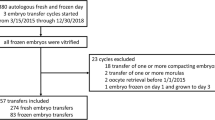Abstract
Purpose
A higher proportion of male offspring has been observed after transferring faster-developing embryos in a number of animal species. Therefore, we evaluated the correlation between the sex ratio of delivered babies and the cleavage stage of transferred embryos in a human IVF-ET program.
Methods
The sex of infants born (n=104) after transfer of exclusively slower-cleaving ≤3 cell (n=41) versus exclusively faster-cleaving ≥4 cell (n=63) embryos was compared. Furthermore, all boys and girls resulting from IVF-ET (n=213) were compared with respect to: the average number of cells in the embryos that were transferred, the embryo with the greatest number of cells in the cohort transferred and the percentage of embryos that were faster cleaving.
Results
Thirty seven percent (15/41) of infants resulting from the transfer of exclusively slower-growing embryos were girls and 38% (24/36) of the infants from the faster growing embryos were girls (NS). The analysis all 213 babies born after 145 embryo transfer procedures did not suggest any differences in embryo cleavage rates in embryo transfers leading to male versus female infants.
Conclusions
A greater number of boys born was not observed after transfer of faster-cleaving embryos as has been described in other animal species. The race to be male may not occur until later cleavage divisions or may not occur in the human embryo.
Similar content being viewed by others
References
Karn MN, Penrose LS: Birth weight and gestation time in relation to maternal age, parity, and infant survival. Ann Eugen 1951;16:147–164
Fog Pedersen JF: Ultrasound evidence of sexual difference in fetal size in first trimester. Br Med J 1980;281:1253
Mittwoch U: Blastocysts prepare for the race to be male. Hum Reprod 1993;8:1550–1555
Tsunoda Y, Tokunaga T, Sugie T: Altered sex ratio of live young after transfer of fast and slow-developing mouse embryos. Gamete Res 1985;12:301–304
Avery B, Madison V, Grieve T: Sex and development in bovine in-vitro fertilized embryos. Theriogenology 1991;35:953–963
Xu KP, Yadav BR, King WA, Betteridge KJ: Sex-related differences in developmental rates of bovine embryos produced and cultured in vitro. Mol Reprod Dev 1992;31:249–252
Author information
Authors and Affiliations
Rights and permissions
About this article
Cite this article
Esther, N.G., Claman, P., Léveillé, M.C. et al. Sex ratio of babies is unchanged after transfer of fast- versus slow-cleaving embryos. J Assist Reprod Genet 12, 566–568 (1995). https://doi.org/10.1007/BF02212575
Received:
Accepted:
Issue Date:
DOI: https://doi.org/10.1007/BF02212575



